SC and Unity: two boots - a pair
On October 5, the Dell EMC Forum was held in Moscow, which brought together more than 800 representatives of customers and partners. Currently, there are 138,000 Dell EMC employees in 180 countries who produce a wide range of products and solutions.

During the forum, Dell EMC experts presented and demonstrated the capabilities of the updated mid-range storage system.
According to analysts, Dell EMC has retained its first place in the market of suppliers of convergent systems and integrated infrastructures, and for 12 quarters holds the first place in the market of flash arrays.
Not for the first year they have been talking about the convergence of the performance indicators and the functionality of data storage systems of the middle and senior classes. This trend continues today.
')
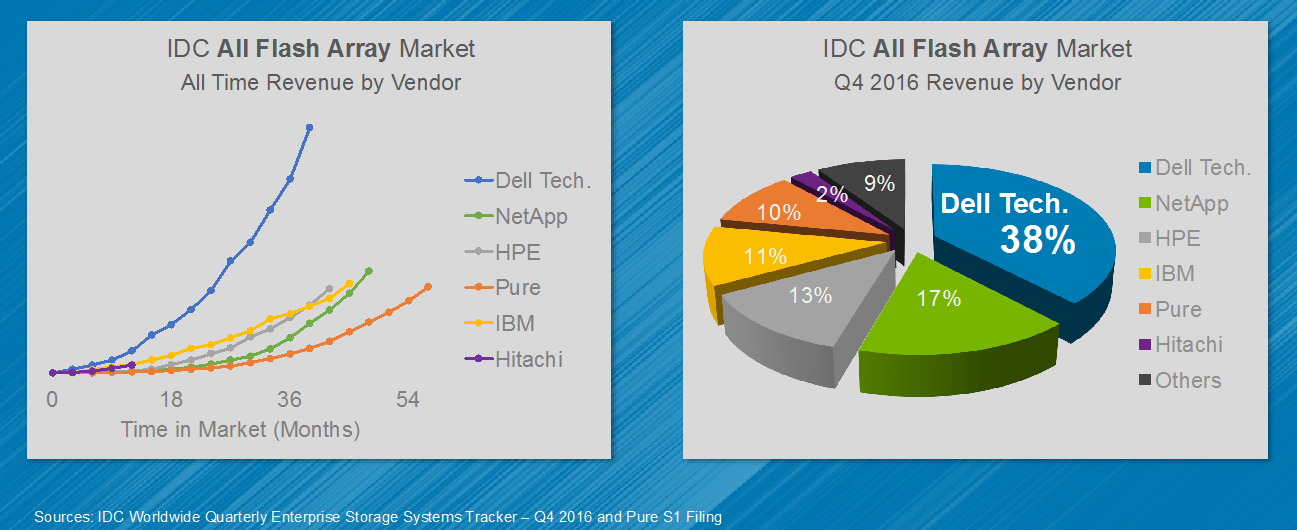
Dell Technologies leads the global flash array market.
As IDC analysts say, Russian customers have begun to give preference to storage systems built entirely on flash memory (all-flash array, AFA). According to the results of the first half of 2017, such systems occupy 23.7% of the market, and their deliveries showed an annual growth of 86.5% in monetary terms.
According to analysts, systems built on flash memory provide so valuable advantages for all customers of any scale that the number of requests for specifications grows with all manufacturers of such solutions.
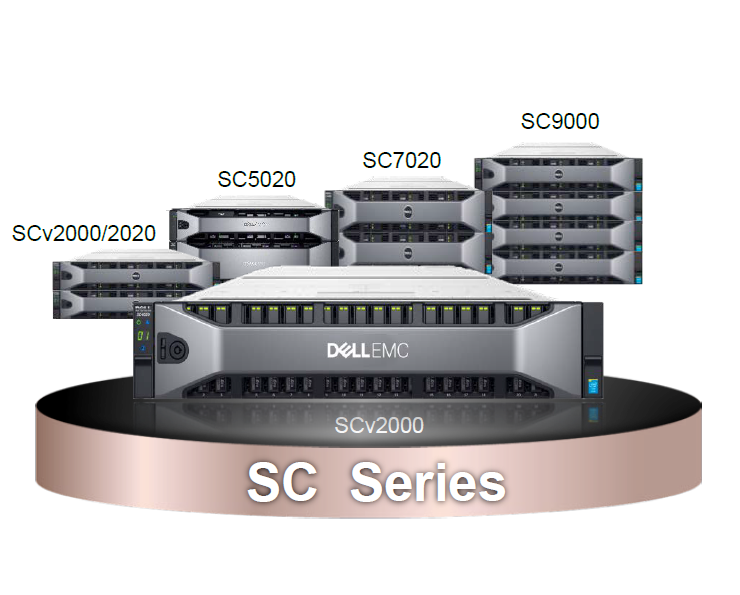
As demonstrated by the implementation of Dell EMC customers, switching to middle-class arrays with flash memory gives a dramatic increase in performance (for example, it increased 17 times for one of the clients), allows you to generate reports (up to 10 times) faster and so on.
At Dell EMC, we developed a special methodology for examining the customer's IT infrastructure, which, by collecting statistics from its various components, makes a financial calculation of the potential benefits of implementing flash memory in various sections: performance, operational, business level and financial level (including, for example, maintenance and support costs).
The result will be short and detailed reports showing how much the IT infrastructure will improve when switching to flash memory. They can serve as a feasibility study for such migration. What makes the transition to flash arrays?
This advantage is far from exhausted. It is not by chance that flash drives today are widely used in middle class storage systems (midrange storage).

In the global market for external storage of the middle class, the combined company is significantly ahead of the competition.
Dell EMC storage systems of the middle class are now represented by two families - SC Series and Unity. Despite the different architecture, they now have a single operating system. They are supported by a number of Dell EMC software products, including data protection. There is also a special cloud service for monitoring and proactive storage support. Forms and a uniform management interface for HTML5 in Unisphere.
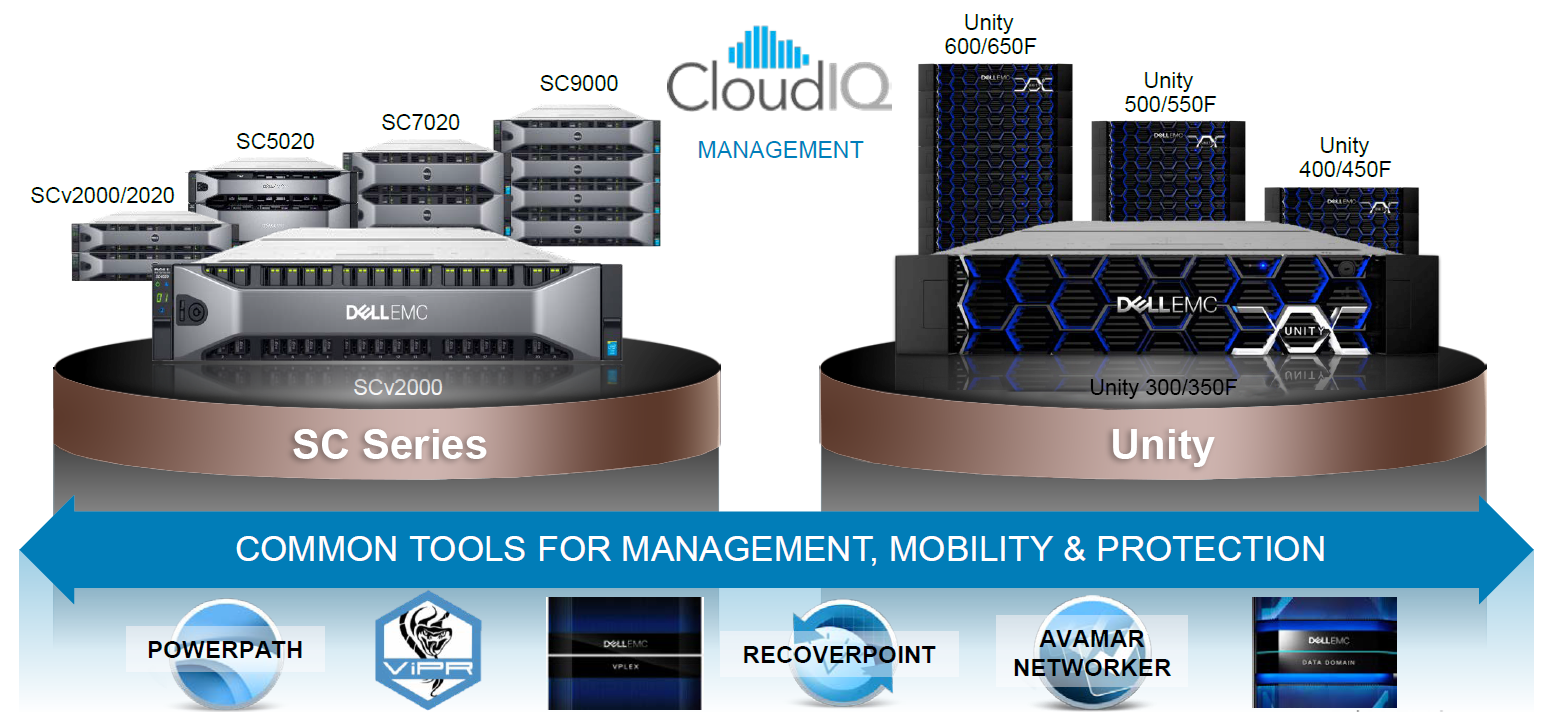
Dell's new EMC midrange storage line allows you to use common management and data protection tools.

Unisphere for SC software is compatible with most modern browsers and does not need to be downloaded or installed separately. Cloud application CloudIQ provides centralized monitoring and reporting, supports planning and optimization. Dell Storage Manager with advanced features will manage and monitor SC and PS arrays (up to 10 arrays).
However, SC and Unity are significantly different products. Key features of the SC-series:
Key properties of the Unity family:
Consider them in more detail.
SC series arrays are designed for tasks that require power, flexibility and availability. They can combine different types of flash memory, for example, add a small amount of enterprise-class flash drives to low-cost SSDs, which allows you to get very low latency in a relatively economical “hybrid” flash array or create new interesting solutions with the advent of new types of non-volatile memory . In 2013, thanks to this combination, Dell was one of the first to introduce low-cost TLC memory to the corporate market.
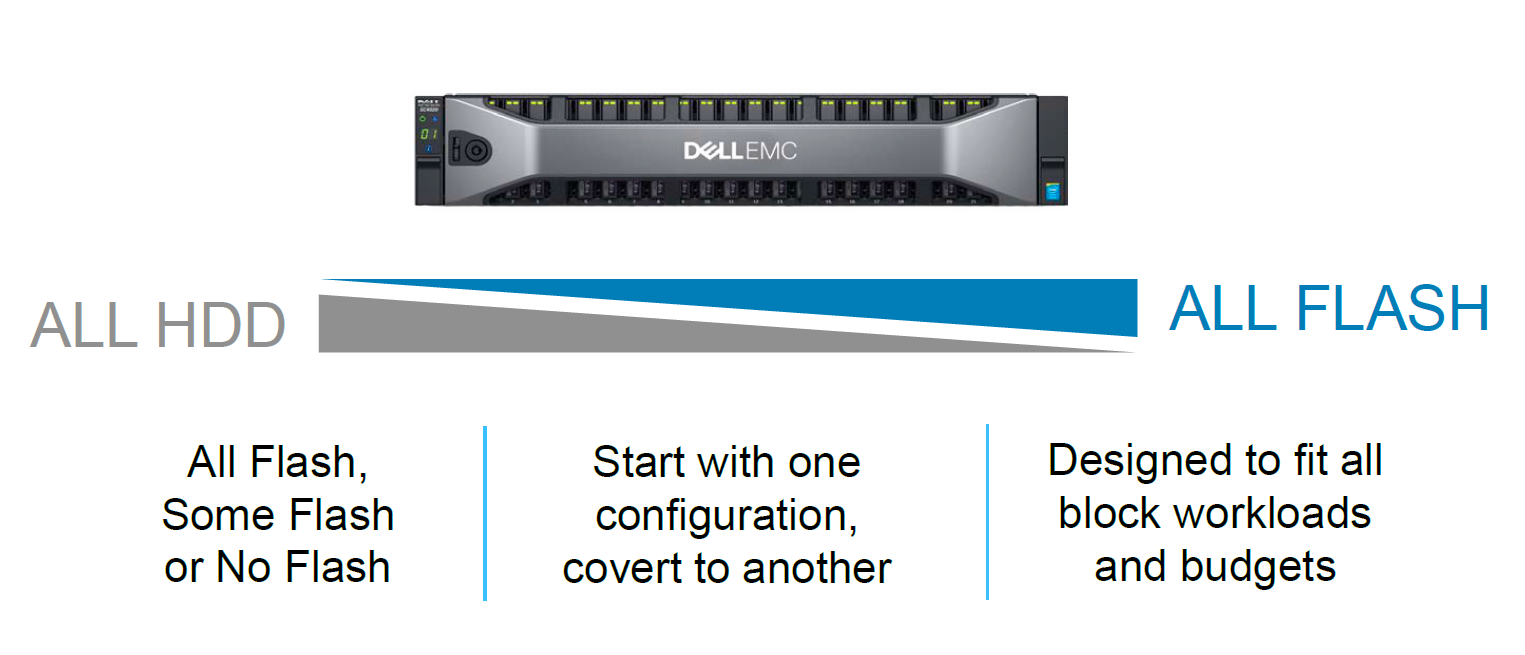
SC Series are flexible hybrid configurations, from 0 to 100% flash memory, which can be added as needed, replacing the HDD.
Drives in SC arrays can be changed on the go, combine HDD and SSD, replace some types of drives with others. In the same system, different types of SAS and NL-SAS drives can be used at the same time with different speeds of rotation and data transfer. For example, you can use solid-state drives with high write and read intensity (Write-Intensive and Read-Intensive), hard drives with 15,000, 10,000, 7,200 rpm.
New arrays provide faster workloads, saving through automation. Thanks to the automatic optimization of solid-state drives, hard drives, or hybrid configurations, the SC Series is positioned as an inexpensive and high-performance solution for multi-functional environments.
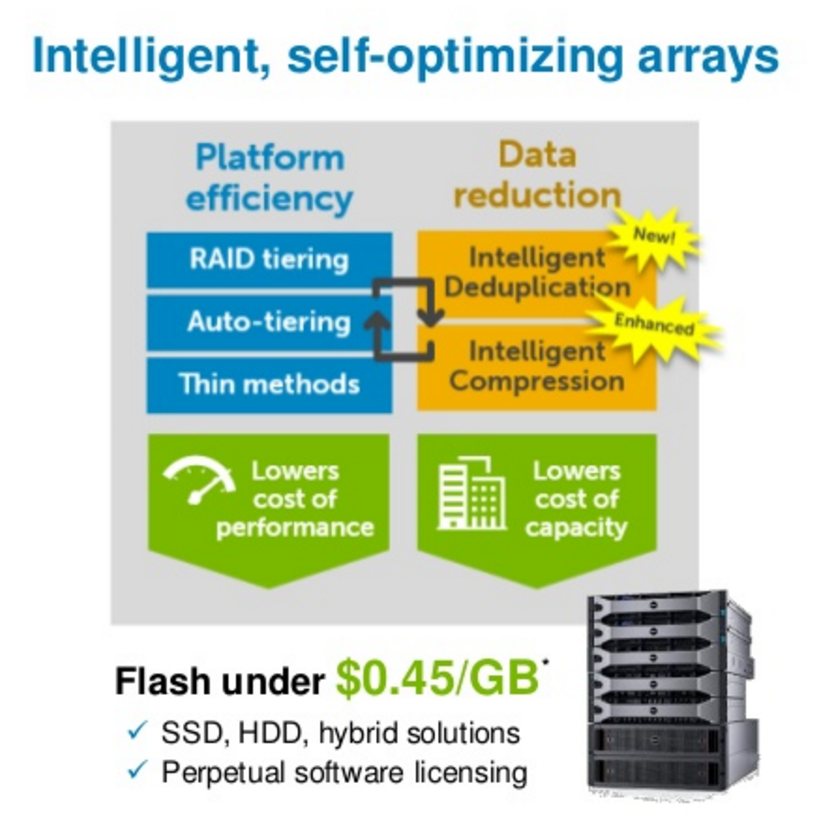
The SC series has the lowest cost per gigabyte storage with hybrid and flash drives.
Among the advantages of the solution are the following.
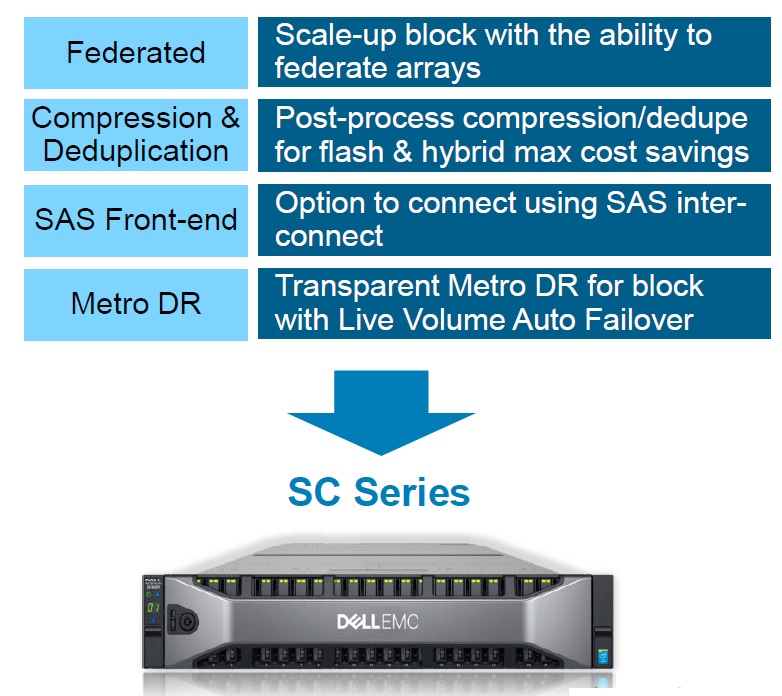
The SC Series is granular tearing (automatic storage tiering), efficient hybrid configurations (0-100% flash memory), intelligent compression and data deduplication, saving software licenses when upgrading, and the possibility of building disaster-proof solutions and federating arrays.
The Data Progression technology used in the SC series arrays dynamically adjusts the configuration of various levels of drives and RAID based on actual usage and application data. This achieves optimal performance and savings. By default, all new data is written to the fastest first-tier drives with RAID 10 performance. Then they are converted to economical RAID 5/6 levels on the same drives for later reading.
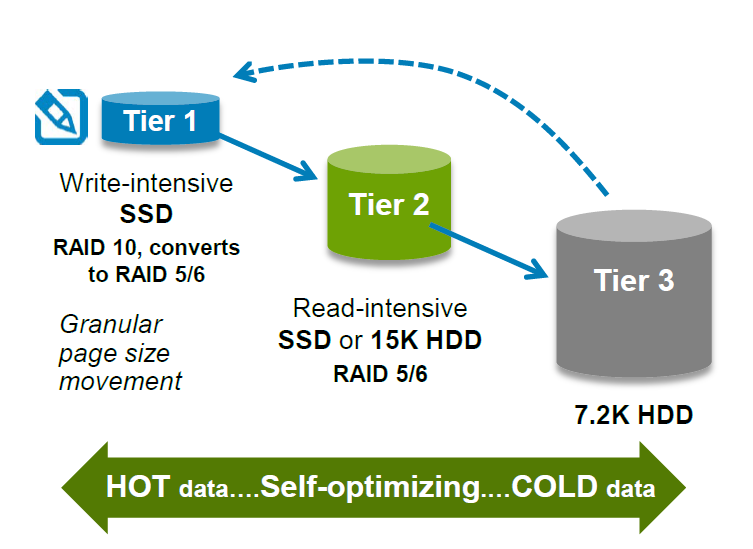
Granular tearing (Data Progression) allows you to balance storage costs and performance. Inactive, “cooling” data snapshots are compressed and automatically moved to a slower lower level of storage.
Aging data is transferred to less expensive storage devices and stays there until needed again. The optimal placement of data for quick access allows, firstly, to save, and secondly, to achieve high speed in IOPS.
And now - about the new product. The new generation SC5020, replacing the popular SC4020, includes two eight-core Intel processors, four times the memory capacity, and an internal 12 Gbps SAS interface. The SC5020 has the following advantages.
Model Dell EMC SC5020 - one of the best in performance among the systems of this class. This new array has a universal 3U chassis (two hot swappable controllers, internal drive bays, network ports and expansion ports).
The new universal case of the 3U form factor contains 30 drive bays and two hot-swappable controllers. The total physical capacity of such a compact device is up to 460 TB. A variety of expansion shelves are also offered, allowing you to grow capacity up to 2 PB per array. Greater horizontal expansion (scale-out) in federated systems with multiple arrays is also available.
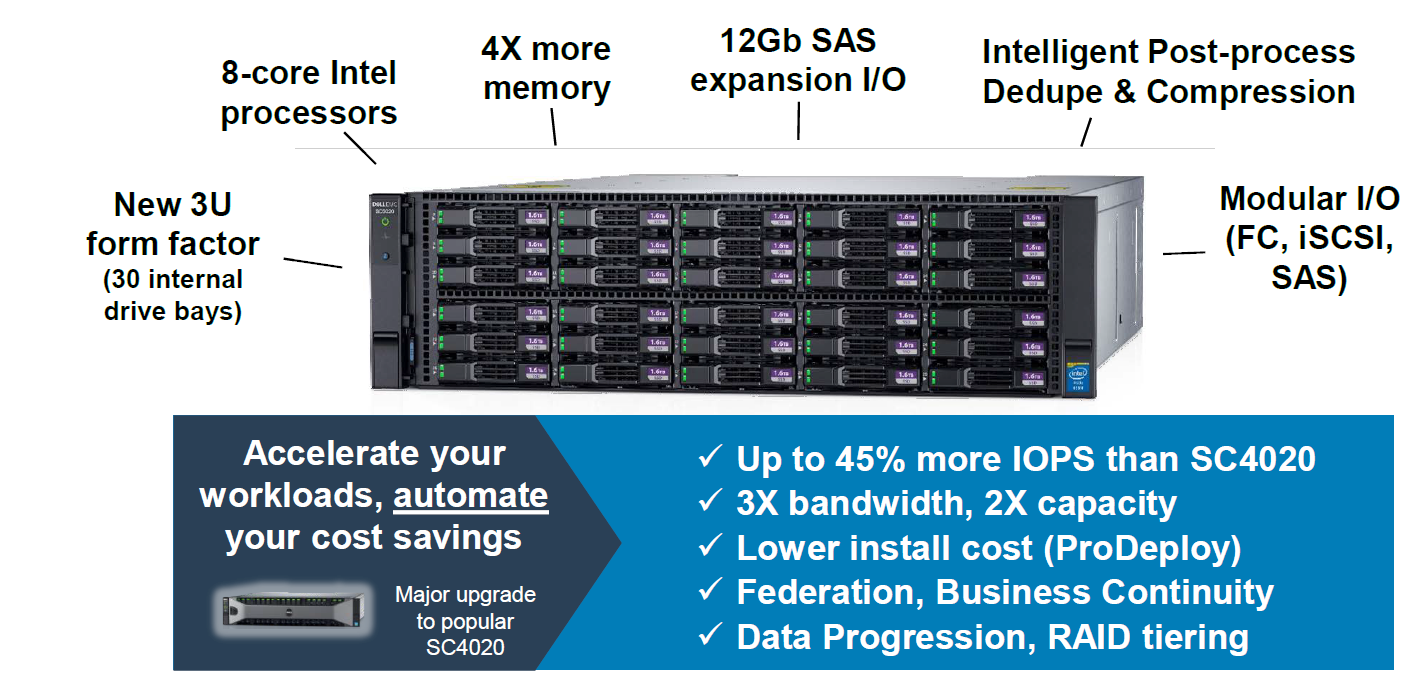
Onboard the Dell EMC SC5020 is an Intel Xeon E5-2630 v3 processor, (2.4 GHz, 8 cores), 128 GB system memory (64 GB per controller) and 30 bays for 2.5 "form factor drives. Maximum physical capacity of the array - 2 PB (solid-state drives or hard drives).

The Dell EMC SC5020 now has more options and backup options.
SC series systems perform intelligent compression, that is, analyze data types and compress them so that they have minimal impact on performance.
The recently announced SCv array has high availability and also supports federation. For backup, you can connect inexpensive arrays on the HDD to it. Now the SCv (Value) series has become fully functional: almost all restrictions have been lifted, except for the possibility of upgrading to a new generation of arrays with retaining licenses.
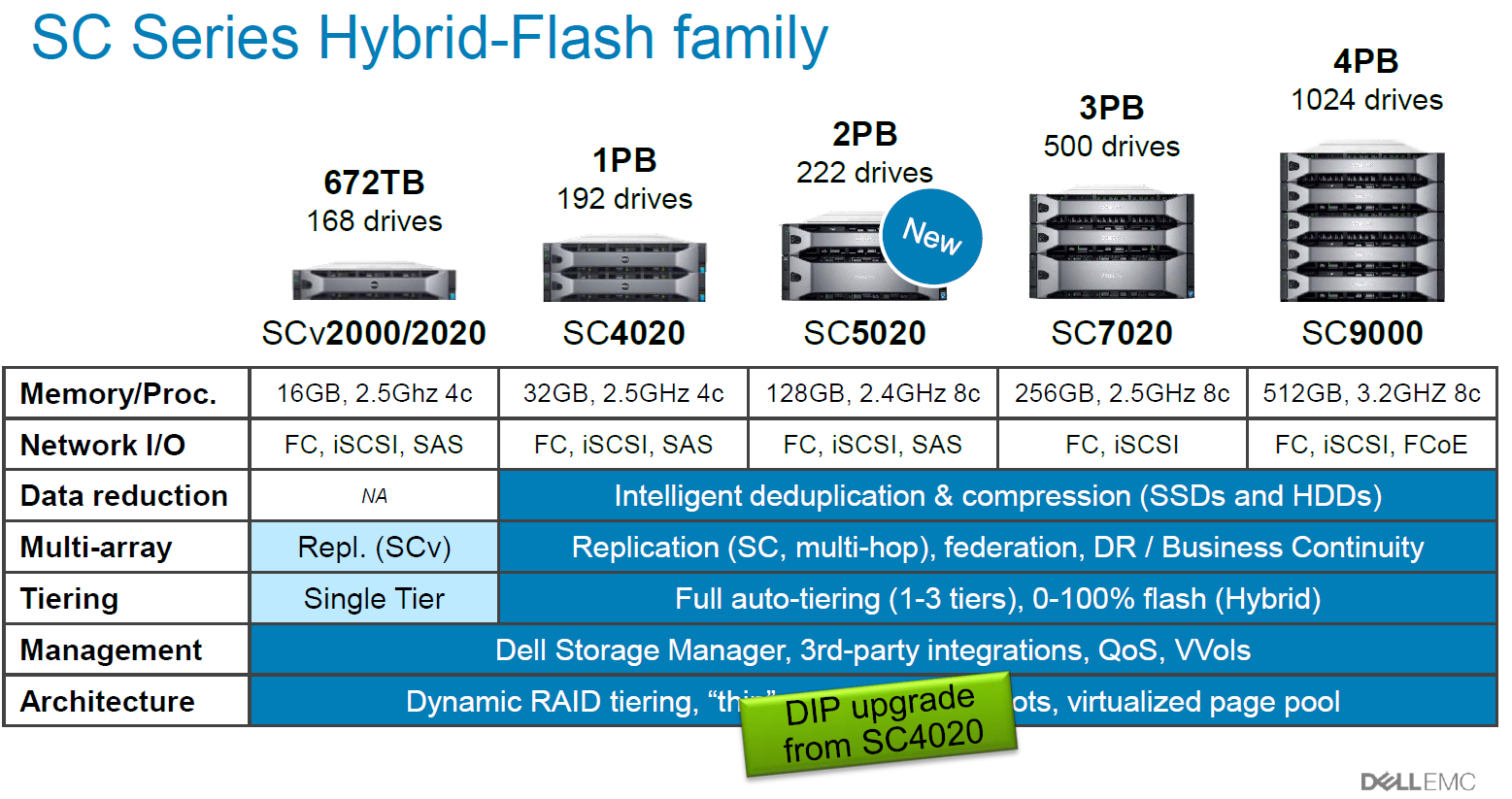
The SC Series array now looks like this.
In today's storage arrays, components are widely used for standard architecture servers. This avoids the high costs associated with the development and production of specialized microcircuits (ASIC) and focuses on software-implemented features.
With the increase in processing power of processors and the advent of flash memory, the middle class first began to compete with older storage systems in performance. This was facilitated by a simpler dual-controller architecture, the absence of a distributed cache, a simpler and faster program code in comparison with older products. Only a few applications (for example, large DBMS), not enough speed of the middle class systems.
With regard to reliability, according to this indicator (and not only), older-class storage systems can be fully contested by the federation of middle-class arrays. A federation is a storage group. Although each individual middle-class system (usually a dual-controller) in such a group is inferior to an older storage system in terms of reliability, the federation of storage systems with the ability to transfer workload between systems without interrupting application work has high availability.
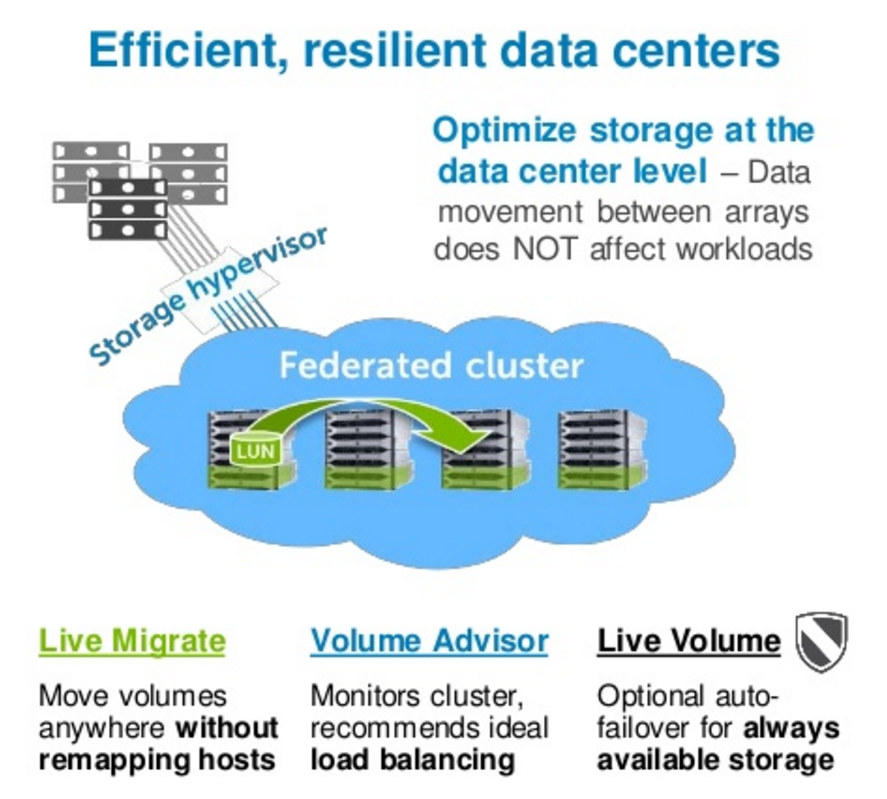
Live Migrate and Volume Advisor technologies simplify work with multiple arrays by moving data, as well as preventive recommendations for load balancing.
The probability of downtime due to errors, the “human factor,” is significantly reduced, while the maintenance of high-end storage systems is a complex task that requires very high qualifications. Another feature is the lower risk of updating the firmware in the federation of arrays. It can be tested on a single site without compromising the entire storage infrastructure. Yes, and TCO at the farm systems of the middle class is usually lower than that of the older storage systems.
In the SC series, the Dell EMC promotes a federated approach to building storage systems. Any array in this series can be part of a 16-controller federation of arrays. Capacity can be increased both vertically, inside the array, and horizontally, combining up to 8 arrays. Such a federation can compete in its characteristics with high-end storage systems.
Those who need a simpler solution will be interested in the Unity family.
Unity is a system that requires minimal effort during setup and maintenance. It is built on the basis of convergent controllers that support various protocols and functions of working with data, unified services for all objects (replication, compression, protection, restoration, etc.).
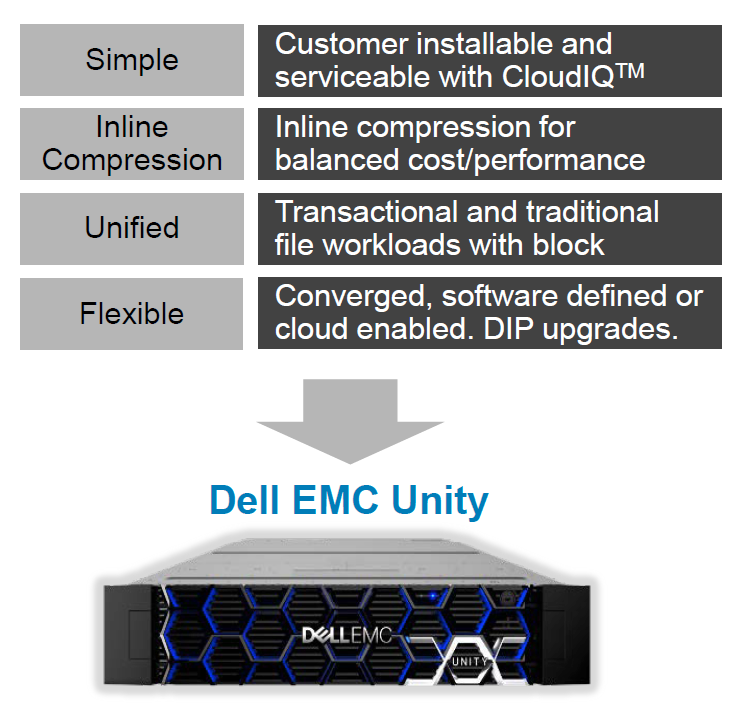
Easy-to-use Unity flash arrays with unified (block and file) access provide a stable response time, integrate with cloud storage services, support an upgrade without data migration.
New data storage technology - dynamic pools - allows you to move from static to dynamic memory expansion, gives high operational flexibility and ease of increasing system capacity. Compression is performed in inline mode - at the controller level. Compressed data is stored in compressed form. The system also automates the work with data snapshots.

Unity Unified Architecture In the basic configuration, this universal storage system is installed in 30 minutes.
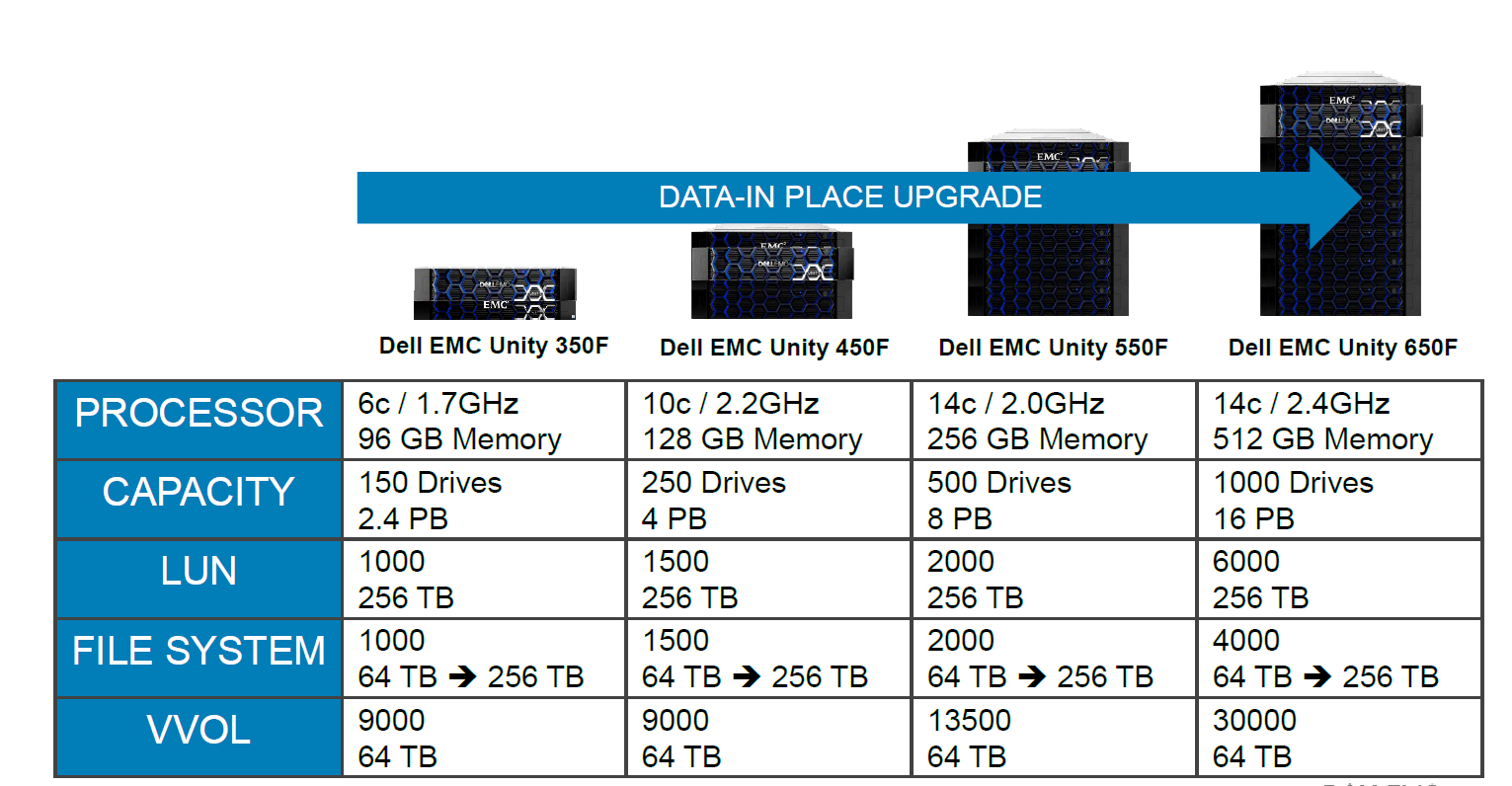
Capacity and Performance Capacity Dell EMC Unity All-Flash does not require data migration.
The Dell EMC Unity All-Flash line with 3D TLC NAND memory is optimized for high performance. It uses up to 40% more computational cores, twice the amount of RAM, a 3U shelf of high density for 80 drives. Capacity is up to 500 TB per rack. The performance of working with files has increased fourfold.

Dynamic pools save capacity and budget, require less time to rebuild.
The systems support block and file compression (inline), dynamic pools, new RAID technologies, provides built-in data copy management functions, including copying data snapshots to cloud storage.
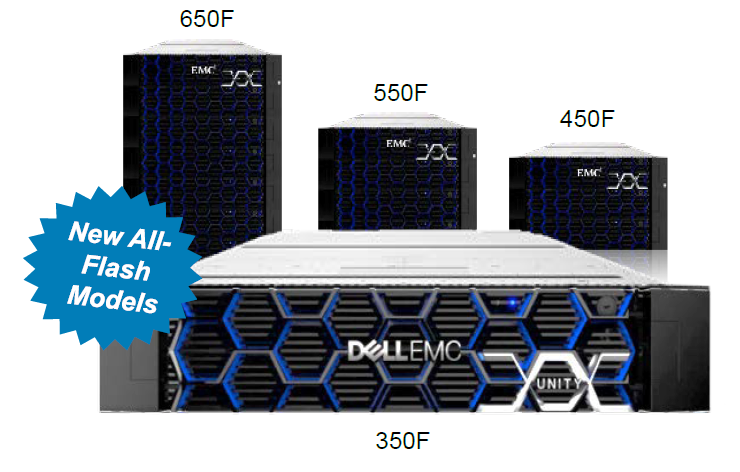
Dell EMC Unity storage customers receive a 4: 1 warranty. That is, the system can store logical information, four times its capacity.
So, the SC Series arrays are characterized by the lowest storage cost per gigabyte among flash arrays (AFA), good integration into PowerEdge servers, built-in deduplication and automatic tiring, and the ability to create an arrays federation. Unity storage system is a complete unification, ease of deployment and use that comes bundled with the software system.

SC Series arrays optimized for working with servers and achieving best economic performance and easy-to-use storage systems will evolve together.
Taken together, these two lines that are popular with customers allow customers to solve a large number of tasks. Dell EMC intends to preserve and develop both middle-class platforms: universal and easy-to-use Unity storage systems and high-performance, cost-effective and flexible SC Series arrays.

During the forum, Dell EMC experts presented and demonstrated the capabilities of the updated mid-range storage system.
According to analysts, Dell EMC has retained its first place in the market of suppliers of convergent systems and integrated infrastructures, and for 12 quarters holds the first place in the market of flash arrays.
Offensive flash arrays
Not for the first year they have been talking about the convergence of the performance indicators and the functionality of data storage systems of the middle and senior classes. This trend continues today.
')

Dell Technologies leads the global flash array market.
As IDC analysts say, Russian customers have begun to give preference to storage systems built entirely on flash memory (all-flash array, AFA). According to the results of the first half of 2017, such systems occupy 23.7% of the market, and their deliveries showed an annual growth of 86.5% in monetary terms.
According to analysts, systems built on flash memory provide so valuable advantages for all customers of any scale that the number of requests for specifications grows with all manufacturers of such solutions.

As demonstrated by the implementation of Dell EMC customers, switching to middle-class arrays with flash memory gives a dramatic increase in performance (for example, it increased 17 times for one of the clients), allows you to generate reports (up to 10 times) faster and so on.
At Dell EMC, we developed a special methodology for examining the customer's IT infrastructure, which, by collecting statistics from its various components, makes a financial calculation of the potential benefits of implementing flash memory in various sections: performance, operational, business level and financial level (including, for example, maintenance and support costs).
The result will be short and detailed reports showing how much the IT infrastructure will improve when switching to flash memory. They can serve as a feasibility study for such migration. What makes the transition to flash arrays?
- You can solve performance problems in advance.
- You can afford to perform more data operations: more snapshots of data, more frequent backups, and any other procedures that were not even considered before due to lack of performance.
- You can significantly improve the “user experience” or launch a new service (for example, RPO = 1 hour for cloud service clients).
- You can significantly save on electricity, space and racks.
This advantage is far from exhausted. It is not by chance that flash drives today are widely used in middle class storage systems (midrange storage).

In the global market for external storage of the middle class, the combined company is significantly ahead of the competition.
SC and Unity arrays
Dell EMC storage systems of the middle class are now represented by two families - SC Series and Unity. Despite the different architecture, they now have a single operating system. They are supported by a number of Dell EMC software products, including data protection. There is also a special cloud service for monitoring and proactive storage support. Forms and a uniform management interface for HTML5 in Unisphere.

Dell's new EMC midrange storage line allows you to use common management and data protection tools.

Unisphere for SC software is compatible with most modern browsers and does not need to be downloaded or installed separately. Cloud application CloudIQ provides centralized monitoring and reporting, supports planning and optimization. Dell Storage Manager with advanced features will manage and monitor SC and PS arrays (up to 10 arrays).
However, SC and Unity are significantly different products. Key features of the SC-series:
- Built-in metrocluster, stretched pad.
- Federation of arrays.
- No alternative data snapshots.
- High technical characteristics (processors, controllers, memory, 32 Gb / s FC interfaces, etc.).
Key properties of the Unity family:
- Inline-compression (at the controller level).
- Built-in NAS.
- All software is included in the basic package.
- Unisphere management system with VMware support.
- Simple and clear array.
- Unity virtual storage.
Consider them in more detail.
Dell EMC SC Series arrays
SC series arrays are designed for tasks that require power, flexibility and availability. They can combine different types of flash memory, for example, add a small amount of enterprise-class flash drives to low-cost SSDs, which allows you to get very low latency in a relatively economical “hybrid” flash array or create new interesting solutions with the advent of new types of non-volatile memory . In 2013, thanks to this combination, Dell was one of the first to introduce low-cost TLC memory to the corporate market.

SC Series are flexible hybrid configurations, from 0 to 100% flash memory, which can be added as needed, replacing the HDD.
Drives in SC arrays can be changed on the go, combine HDD and SSD, replace some types of drives with others. In the same system, different types of SAS and NL-SAS drives can be used at the same time with different speeds of rotation and data transfer. For example, you can use solid-state drives with high write and read intensity (Write-Intensive and Read-Intensive), hard drives with 15,000, 10,000, 7,200 rpm.
New arrays provide faster workloads, saving through automation. Thanks to the automatic optimization of solid-state drives, hard drives, or hybrid configurations, the SC Series is positioned as an inexpensive and high-performance solution for multi-functional environments.

The SC series has the lowest cost per gigabyte storage with hybrid and flash drives.
Among the advantages of the solution are the following.
- Technology Data Progression . Provides the required level of performance in IOPS (I / O operations per second) with an economical combination of storage devices.
- Deduplication and compression . Significantly reduces physical capacity requirements for data storage.
- Automatic distribution of data on RAID levels . Means more efficient use of resources without manual distribution.
- Federation. Allows you to consolidate the storage infrastructure so that it functions as a whole.
- Continuous software licensing schemes. Protect investment and reduce future expansion and upgrade costs.

The SC Series is granular tearing (automatic storage tiering), efficient hybrid configurations (0-100% flash memory), intelligent compression and data deduplication, saving software licenses when upgrading, and the possibility of building disaster-proof solutions and federating arrays.
The Data Progression technology used in the SC series arrays dynamically adjusts the configuration of various levels of drives and RAID based on actual usage and application data. This achieves optimal performance and savings. By default, all new data is written to the fastest first-tier drives with RAID 10 performance. Then they are converted to economical RAID 5/6 levels on the same drives for later reading.

Granular tearing (Data Progression) allows you to balance storage costs and performance. Inactive, “cooling” data snapshots are compressed and automatically moved to a slower lower level of storage.
Aging data is transferred to less expensive storage devices and stays there until needed again. The optimal placement of data for quick access allows, firstly, to save, and secondly, to achieve high speed in IOPS.
And now - about the new product. The new generation SC5020, replacing the popular SC4020, includes two eight-core Intel processors, four times the memory capacity, and an internal 12 Gbps SAS interface. The SC5020 has the following advantages.
- 45% more IOPS per second (IOPS).
- Tripled throughput (GB / s).
- Double maximum capacity.
Model Dell EMC SC5020 - one of the best in performance among the systems of this class. This new array has a universal 3U chassis (two hot swappable controllers, internal drive bays, network ports and expansion ports).
The new universal case of the 3U form factor contains 30 drive bays and two hot-swappable controllers. The total physical capacity of such a compact device is up to 460 TB. A variety of expansion shelves are also offered, allowing you to grow capacity up to 2 PB per array. Greater horizontal expansion (scale-out) in federated systems with multiple arrays is also available.

Onboard the Dell EMC SC5020 is an Intel Xeon E5-2630 v3 processor, (2.4 GHz, 8 cores), 128 GB system memory (64 GB per controller) and 30 bays for 2.5 "form factor drives. Maximum physical capacity of the array - 2 PB (solid-state drives or hard drives).

The Dell EMC SC5020 now has more options and backup options.
SC series systems perform intelligent compression, that is, analyze data types and compress them so that they have minimal impact on performance.
The recently announced SCv array has high availability and also supports federation. For backup, you can connect inexpensive arrays on the HDD to it. Now the SCv (Value) series has become fully functional: almost all restrictions have been lifted, except for the possibility of upgrading to a new generation of arrays with retaining licenses.

The SC Series array now looks like this.
Array Federation
In today's storage arrays, components are widely used for standard architecture servers. This avoids the high costs associated with the development and production of specialized microcircuits (ASIC) and focuses on software-implemented features.
With the increase in processing power of processors and the advent of flash memory, the middle class first began to compete with older storage systems in performance. This was facilitated by a simpler dual-controller architecture, the absence of a distributed cache, a simpler and faster program code in comparison with older products. Only a few applications (for example, large DBMS), not enough speed of the middle class systems.
With regard to reliability, according to this indicator (and not only), older-class storage systems can be fully contested by the federation of middle-class arrays. A federation is a storage group. Although each individual middle-class system (usually a dual-controller) in such a group is inferior to an older storage system in terms of reliability, the federation of storage systems with the ability to transfer workload between systems without interrupting application work has high availability.

Live Migrate and Volume Advisor technologies simplify work with multiple arrays by moving data, as well as preventive recommendations for load balancing.
The probability of downtime due to errors, the “human factor,” is significantly reduced, while the maintenance of high-end storage systems is a complex task that requires very high qualifications. Another feature is the lower risk of updating the firmware in the federation of arrays. It can be tested on a single site without compromising the entire storage infrastructure. Yes, and TCO at the farm systems of the middle class is usually lower than that of the older storage systems.
In the SC series, the Dell EMC promotes a federated approach to building storage systems. Any array in this series can be part of a 16-controller federation of arrays. Capacity can be increased both vertically, inside the array, and horizontally, combining up to 8 arrays. Such a federation can compete in its characteristics with high-end storage systems.
Those who need a simpler solution will be interested in the Unity family.
Unity: out-of-box functionality
Unity is a system that requires minimal effort during setup and maintenance. It is built on the basis of convergent controllers that support various protocols and functions of working with data, unified services for all objects (replication, compression, protection, restoration, etc.).

Easy-to-use Unity flash arrays with unified (block and file) access provide a stable response time, integrate with cloud storage services, support an upgrade without data migration.
New data storage technology - dynamic pools - allows you to move from static to dynamic memory expansion, gives high operational flexibility and ease of increasing system capacity. Compression is performed in inline mode - at the controller level. Compressed data is stored in compressed form. The system also automates the work with data snapshots.

Unity Unified Architecture In the basic configuration, this universal storage system is installed in 30 minutes.

Capacity and Performance Capacity Dell EMC Unity All-Flash does not require data migration.
The Dell EMC Unity All-Flash line with 3D TLC NAND memory is optimized for high performance. It uses up to 40% more computational cores, twice the amount of RAM, a 3U shelf of high density for 80 drives. Capacity is up to 500 TB per rack. The performance of working with files has increased fourfold.

Dynamic pools save capacity and budget, require less time to rebuild.
The systems support block and file compression (inline), dynamic pools, new RAID technologies, provides built-in data copy management functions, including copying data snapshots to cloud storage.

Dell EMC Unity storage customers receive a 4: 1 warranty. That is, the system can store logical information, four times its capacity.
Two families - one product strategy
So, the SC Series arrays are characterized by the lowest storage cost per gigabyte among flash arrays (AFA), good integration into PowerEdge servers, built-in deduplication and automatic tiring, and the ability to create an arrays federation. Unity storage system is a complete unification, ease of deployment and use that comes bundled with the software system.

SC Series arrays optimized for working with servers and achieving best economic performance and easy-to-use storage systems will evolve together.
Taken together, these two lines that are popular with customers allow customers to solve a large number of tasks. Dell EMC intends to preserve and develop both middle-class platforms: universal and easy-to-use Unity storage systems and high-performance, cost-effective and flexible SC Series arrays.
Source: https://habr.com/ru/post/340588/
All Articles